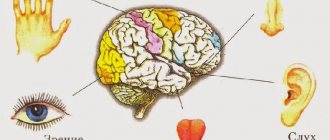Psychological characteristics of speech
Concept of speech
Language is a system of signs and symbols. Speech is the process of using language. Thus, speech is the realization of language, which reveals itself only through speech. Human speech arises in response to the need to communicate with someone or communicate something.
Speech is a form of communication that has developed historically in the course of the material transformative activities of people, mediated by language.
Human speech activity is closely connected with all aspects of human consciousness. Speech is a factor in a person’s mental development, his formation as a personality. All mental processes with the help of speech become voluntary and controllable. Speech is a mental phenomenon, it is individual and bears the imprint of a given individual’s subjective reflection and expression of objective reality and attitude towards it.
Rice. 34. Functions of speech[30]
According to its many functions (Fig. 34), speech is a polymorphic activity, i.e. in its various functional purposes it is presented in different forms and types (Fig. 35, 36).
Rice. 35. Forms of speech
External speech is a system of sound signals, written signs and symbols used by a person to transmit information, the process of materialization of thought. It can be oral and written.
Rice. 36. Types of speech
Oral speech
– verbal (verbal) communication through linguistic means perceived by ear.
Monologue speech is the speech of one person expressing his thoughts over a relatively long time, or a consistent coherent presentation by one person of a system of knowledge. Monologue speech is characterized by consistency and evidence, which are ensured by coherence of thought, grammatically correct design and expressiveness of vocal means. During preparation, such a speech is spoken out repeatedly, the necessary words and sentences are selected, and the plan for the speech is often recorded in writing. Monologue speech has greater compositional complexity, requires completeness of thought, stricter adherence to grammatical rules, strict logic and consistency in the presentation of what the speaker of the monologue wants to say.
Dialogical speech is speech in which all its participants are equally active. Dialogue speech is the psychologically simplest and most natural form of speech. It occurs during direct communication between two or more interlocutors. It is characterized by remarks exchanged between speakers, repetitions of phrases and individual words after the interlocutor, questions, additions, and explanations.
Written speech
– this is speech through written signs (letter, notes, scientific treatise). It is addressed to a wide range of readers, is not situational and requires in-depth skills of sound-letter analysis, the ability to logically and grammatically correctly convey one’s thoughts, analyze what is written and improve the form of expression.
Inner speech is speech that does not perform the function of communication, but only serves the thinking process of a particular person. With the help of internal speech, the process of transforming thoughts into speech and preparing a speech utterance is carried out. Inner speech is a person’s conversation with himself, which expresses thinking, motives of behavior, planning and managing activities.
The following properties of speech are distinguished: content, understandability, expressiveness, and effectiveness (Fig. 37).
Rice. 37. Properties of speech
Basics of neuropsychology
FUNDAMENTALS OF NEUROPSYCHOLOGY.1. Subject, tasks and methods of neuropsychology. Directions of modern neuropsychology. The importance of neuropsychology for medical practice. 2
2. Luria A.R. – founder of Russian neuropsychology. History of the study of the localization of higher mental functions. 2 3. Definition of neuropsychological symptom, syndrome, factor. 3 4. Theory of system dynamic localization of functions. 3 5. The concept of higher mental functions, their specific characteristics. 3 6. Horizontal and vertical organization of the brain. 4 7. Concept of A.R. Luria about three main structural and functional blocks. 8. Specificity of the contribution of structural and functional blocks to the implementation of higher mental functions. 4 9. Functional features of the primary, secondary and tertiary cortical fields of the posterior and anterior parts of the brain. 5 10. Functional asymmetry of the brain. 5 11. Interhemispheric interaction. Interhemispheric connections. Split brain syndrome. 7 12. Lateral features of disorders of gnostic processes, voluntary movements and actions. 9 13. Principles of the structure of the visual analyzer and sensory disorders of its operation. 9 14. Violations of visual gnosis due to lesions of secondary cortical fields. Types of visual agnosia. eleven 15. Violations of visual perception with damage to the left and right hemispheres of the brain (in right-handed people). 12 16. Basic principles of the structure of the skin-kinesthetic analyzer. 12 17. Types of general sensitivity, their receptor apparatus, pathways. Sensory disorders of the skin-kinesthetic system. 12 18. Violations of tactile gnosis due to damage to the secondary fields of the cortex. Types of tactile agnosia. 13 19. Basic principles of the structure of the auditory analyzer and sensory disorders of the auditory system. 13 20. Gnostic auditory disorders with damage to secondary cortical fields. 14 21. Impairment of speech phonemic hearing. 14 22. Afferent and efferent mechanisms of a voluntary motor act. 15 23. Concept by N.A. Bernstein on the level organization of the brain mechanisms of the motor system. 15 24. Pyramid system. Basic principles of structure. Disturbances of motor acts with damage to different levels of the pyramidal system. 16 25. Extrapyramidal system. Basic principles of structure. Movement disorders due to damage to different levels of the extrapyramidal system. 17 26. Apraxia. Classification of apraxia according to A.R. Luria. 19 27. The third structural and functional block of the brain. Agranular and granular cortex. 19 28. Manifestation of violations of voluntary regulation of various forms of mental activity and behavior in general. 19 29. Psychological structure of speech. Expressive and impressive speech. 22 30. Types of speech activity. Speech functions. Peripheral and central mechanisms of speech. 23 31. Aphasia. Definition. Aphasia as a systemic defect. Classification of aphasias (according to A.R. Luria). 23 32. Disorders of the afferent parts of the speech functional system (efferent aphasia). 24 33. Violations of the paradigmatic and syntagmatic organization of speech with damage to the posterior and anterior parts of the cortex of the left hemisphere. 24 34. The role of the right hemisphere in the organization of speech activity. 25 35. Psychological organization of memory processes. Types, forms of memory. 36. Memory impairment. Theories of forgetting. Retroactive and proactive inhibition. 26 37. Modal-nonspecific memory impairments. Modality-specific memory impairments. 27 38. Memory disorders as a mnestic activity. 27 39. Psychological structure of attention. Forms of attention. 28 40. Modally nonspecific attention disorders. Modality-specific attention disorders. Symptoms of “ignoring” stimuli. 28 41. Psychological structure of thinking. Types of thinking. 42. Thinking disorders due to damage to the frontal lobes of the brain. 43. Thinking disorders due to damage to the posterior parts of the brain. 44. Thinking disorders with damage to the temporal and premotor parts of the brain. 29 45. Disorders of the emotional and personal sphere in local brain lesions. 31
Subject, tasks and methods of neuropsychology. Directions of modern neuropsychology. The importance of neuropsychology for medical practice.
Neuropsychology
is a branch of clinical psychology that studies the brain mechanisms of HMF and the emotional-personal sphere using the material of local brain lesions and other models.
A common task for all areas: the study of brain mechanisms of mental processes.
Areas of neuropsychology:
1. Clinical neuropsychology (for local brain lesions). Objective: to study neuropsychological syndromes that occur when a particular area of the brain is damaged and compare them with the general clinical picture of the disease.
2. Rehabilitation direction – rehabilitation after local brain damage. Objective: restoration of HMFs impaired due to local brain lesions.
3. Experimental neuropsychology – studies disorders of the HMF using experiments. Objective: experimental (clinical and instrumental) study of various forms of disturbances of mental processes in local brain lesions and other diseases of the central nervous system.
4. Neuropsychology of childhood. Specificity of mental function disorders in children with local brain lesions.
5. Neuropsychology of old age (from 45 years old).
6. Neuropsychology of individual differences - profile-lateral organization is studied. Objective: to study the brain organization of mental processes and states in healthy individuals. Answer to the question: is it possible, in principle, to extend the general neuropsychological ideas about the cerebral organization of the psyche, developed during the study of the consequences of local brain lesions, to the study of the cerebral mechanisms of the psyche of healthy individuals. Psychodiagnostics using neuropsychological knowledge for the purposes of professional selection, career guidance, etc.
7. Neuropsychology of borderline states. Analysis of changes in HMF under the influence of psychopharmacological drugs.
8. Psychophysiological direction – HMFs are studied using psychophysiological methods. Subject of neuropsychology
is the study of the cerebral organization of mental processes, emotional states and Personality on the basis of pathology and, above all, on the material of local brain lesions.
Catalog:
ld -> Editorial article Social stress, work motivation and health ld -> Educational and methodological manual on the aspect of “Oral speech” for third-year students of the Faculty of English ld -> Compiled by: Candidate of Psychological Sciences, Assoc. Gabdreeva G. Sh ld -> English literary autobiography: transformation of the genre in the 20th century ld -> The program is designed to create psychological and pedagogical conditions for the successful adaptation of students in the first, fifth and tenth grades to the peculiarities of the educational environment of the school, preserving the psychological health of schoolchildren ld -> Goldfarb Olga Sergeevna Candidate of Psychological Sciences, Associate Professor ld -> 1 Family as a factor in the formation of a child’s aggressive behavior... ld -> Features of the personal adaptive potential of conscripted military personnel ld -> Consultation for parents “Going to kindergarten”
1.66 Mb.
Share with your friends:
Literature:
1. Akhutina T.V. Generation of speech. M., 1989.
2. Vygotsky L.S. Collected works. T. 2. M., 1982.
3. Zhinkin N.I. Mechanisms of speech. M., 1958.
4. Leontyev A.A. The word in speech activity. M., 1965.
5. Luria A.R. Language and consciousness. M., 1979.
6. Nemov R.S. Psychology. Book 1. General fundamentals of psychology. M., 1994.
7. Sokolov A.N. Inner speech and thinking. M., 1968.
8. Chomsky N. Language and thinking. M., 1972.
9. Ushakova T.N. etc. Human speech in communication. M., 1989.
Functions of speech
There are a large number of functions for which human speech is responsible:
- communicative function
- mystical function
- expressive function
- smart function
- regulatory function
The communicative function is the reception and transmission of information code between individuals. The communicative function is the most important and fundamental.
The mental function means that information obtained as a result of communication is transferred by the brain to a person’s memory during verbalization.
The expressive function of speech activity gives a person the opportunity to demonstrate his attitude to other objects, phenomena, events, actions, evaluate these events from his subjective point of view, and his emotional state.
The intellectual function of speech gives a person the ability to think. Speech has a connection not only with thinking, but also with human consciousness. This function is expressed in the fact that a person is able to describe the current situation using compact formulations, and vice versa, can quickly understand what the interlocutor is talking about when he succinctly expresses his thought.
The regulatory function is expressed in the fact that a person is able to demonstrate his voluntary, volitional behavior.
Psychological functions and properties of speech
There are four main functions of speech:
- Expression
It is through speech that people can show their attitude towards any object, situation or individual.
- Message
It is through words that people exchange information.
- Designation
This function is expressed in determining the name of an object or phenomenon.
- Influence
Through speech, a person can influence the emotional state, thoughts, assumptions and behavior of people around him.
Properties of speech include:
- Content
The depth and volume of speech is important, which affects its informativeness.
- Understandability
A person must be able to correctly and clearly express what he wants to convey to his interlocutor.
- Expressiveness
The emotional coloring of speech when communicating with other people is important.
- Influence
This property of speech reflects a person’s ability to influence other people.
Finished works on a similar topic
Course work Psychological analysis of speech 400 ₽ Essay Psychological analysis of speech 250 ₽ Test paper Psychological analysis of speech 240 ₽
Receive completed work or specialist advice on your educational project Find out the cost
All functions and properties of speech are very important for humans. They play a very important role in the formation of personality. If some property of a person’s speech is impaired, this can lead to bad consequences. To avoid them, you need to know all the functions and properties of speech and work on mastering them. The type of speech a person uses is also important. After all, all types are important in their own way and necessary for a person in the process of his life.









